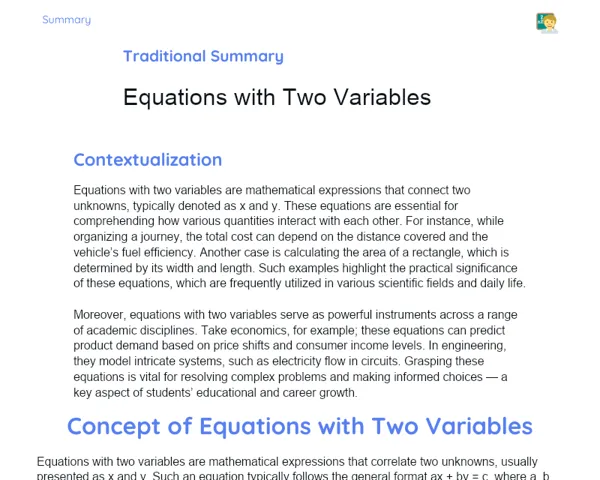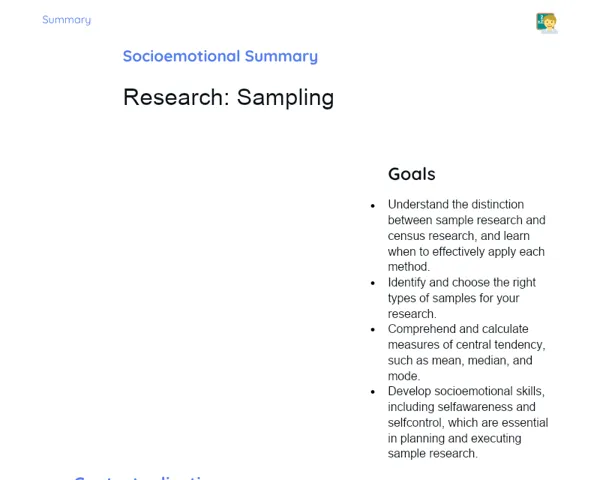Summary Tradisional | Elements of a Sequence
Contextualization
Mathematical sequences represent ordered lists of numbers that follow a specific rule. These rules dictate how each number in the list is derived from the preceding ones. A straightforward example is the sequence of even numbers: 2, 4, 6, 8, where each number is formed by adding 2 to the previous number. Grasping these rules is vital for spotting patterns and anticipating future terms in the sequence.
Sequences don't just exist in mathematics; they also appear in various facets of our daily lives and in nature. For instance, the Fibonacci sequence can be seen in the arrangement of flower petals, the structure of pine cones, and even in the formation of galaxies. Furthermore, sequences play a significant role in technology, such as in data compression techniques and cryptography, underscoring their practical relevance across different domains.
To Remember!
Definition of Sequence
A sequence is an ordered list of numbers governed by a specific rule. This rule outlines how each number is generated from the preceding ones. For instance, in the sequence 2, 4, 6, 8, the rule is to add 2 to the previous number.
Understanding what constitutes a sequence is crucial since it forms the basis for recognizing and working with various types of sequences. Without this comprehension, it becomes challenging to identify patterns or predict upcoming terms. The sequence can be perceived as an organized system where each component has a specific position and value dictated by the defining rule.
Studying sequences helps students enhance their analytical skills to recognize patterns and regularities. This skill is essential not just in mathematics but also in fields like computer science and biology, where patterns and sequences hold fundamental significance.
-
Sequence: ordered list of numbers.
-
Specific rule defines the sequence.
-
Importance of recognizing patterns.
Arithmetic Sequence
An arithmetic sequence is a series of numbers in which the difference between consecutive terms remains constant. This constant difference is referred to as the 'common difference'. The general formula to calculate the n-th term of an arithmetic sequence is: a_n = a_1 + (n-1)d, where a_1 is the first term and d is the common difference.
For example, in the sequence 3, 6, 9, 12, the common difference is 3. By applying the formula, we can determine any term in the sequence. If we want to find the 10th term, we substitute the values into the formula: a_10 = 3 + (10-1) * 3 = 3 + 27 = 30.
Arithmetic sequences find extensive application in various fields, including finance and engineering. They assist in modelling situations where there is a consistent change, such as simple interest or linear growth.
-
Constant difference between consecutive terms.
-
Formula: a_n = a_1 + (n-1)d.
-
Applications in finance and engineering.
Geometric Sequence
A geometric sequence is a series of numbers where the ratio between consecutive terms is constant. This constant ratio is called the 'common ratio'. The general formula for finding the n-th term of a geometric sequence is: a_n = a_1 * r^(n-1), where a_1 is the first term and r is the common ratio.
For example, in the sequence 2, 4, 8, 16, the common ratio is 2. Using this formula, we can find any term in the sequence. If we wish to find the 7th term, we replace the values in the formula: a_7 = 2 * 2^(7-1) = 2 * 64 = 128.
Geometric sequences frequently emerge in contexts involving exponential growth, including compound interest, radioactive decay, and population dynamics. They are essential for understanding phenomena that increase or decrease at consistent rates.
-
Constant ratio between consecutive terms.
-
Formula: a_n = a_1 * r^(n-1).
-
Applications in exponential growth.
Pattern Identification
Identifying patterns within sequences is a key skill for forecast future terms and comprehending the rule that outlines the sequence. Spotting patterns involves observing the differences or ratios between consecutive terms and applying this information to extract the general rule.
For instance, in the sequence 2, 5, 10, 17, 26, we notice that the differences between the consecutive terms are 3, 5, 7, and 9. These differences themselves form an arithmetic sequence, indicating that the rule for forming the original sequence involves adding consecutive odd numbers.
The ability to detect patterns is beneficial not only in mathematics but in fields like data science and cryptography, where recognizing patterns can lead to solving intricate problems and decrypting information.
-
Observation of differences or ratios between terms.
-
Determining the general rule of the sequence.
-
Applications in data science and cryptography.
Key Terms
-
Sequence: Ordered list of numbers that follows a specific rule.
-
Arithmetic Sequence: A sequence in which the difference between consecutive terms remains constant.
-
Geometric Sequence: A sequence in which the ratio between consecutive terms is constant.
-
Common Difference: Constant difference in an arithmetic sequence or constant ratio in a geometric sequence.
-
Patterns: Regularities or rules that determine the formation of a sequence.
Important Conclusions
In this lesson, we delved into the concept of mathematical sequences, which are ordered lists of numbers that adhere to a specific rule. We recognized the significance of understanding these rules to identify patterns and anticipate future terms, emphasizing the relevance of this knowledge in various aspects of life and science.
We explored two principal categories of sequences: arithmetic and geometric. Arithmetic sequences maintain a consistent difference between consecutive terms, while geometric sequences have a constant ratio. We learned how to utilize formulas to determine specific terms in both sequence types, which is vital for addressing practical problems.
Moreover, we highlighted the skill of pattern identification in sequences, a fundamental capability not only for mathematics but also for sectors like data science and cryptography. This skill is instrumental in resolving complex issues and decoding information, illustrating the practical applications and importance of the concepts we have studied.
Study Tips
-
Review the practical examples discussed in class and try solving similar problems to strengthen your grasp of the formulas for arithmetic and geometric sequences.
-
Practice identifying patterns in different numerical sequences, noting the rule that defines each sequence and calculating future terms.
-
Explore additional resources, such as textbooks and educational videos, to broaden your understanding of sequences and their applications across various contexts.



